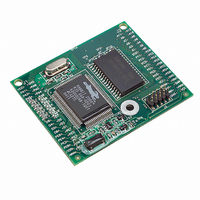20-101-0383 Rabbit Semiconductor, 20-101-0383 Datasheet - Page 18

20-101-0383
Manufacturer Part Number
20-101-0383
Description
MODULE RABBITCORE RCM2020
Manufacturer
Rabbit Semiconductor
Datasheet
1.20-101-0383.pdf
(80 pages)
Specifications of 20-101-0383
Module/board Type
MPU Core Module
Product
Microcontroller Modules
Core Processor
Rabbit 2000
Clock Speed
18.432 MHz
Interface Type
Ethernet, Serial
Flash
256 KB
Timers
5 x 8 bit, 2 x 10 bit
Operating Supply Voltage
4.75 V to 5.25 V
Board Size
48.3 mm x 58.4 mm x 14 mm
Core
RCM2020
Processor Series
RCM2000
For Use With/related Products
RCM2020
Lead Free Status / RoHS Status
Lead free / RoHS Compliant
Other names
316-1082
You can set break points while the program is running by positioning the cursor to a state-
ment and using the
take place.You can toggle the break point off with the
the
3.1.1.4 Editing the Program
Click on the
you can change the program. Use the
with a new name so as not to change the demo program. Save the file as
change the number 25000 in the
recompile and run the program. The LED will start flashing, but it will flash much faster
than before because you have changed the loop counter terminal value from 25000 to
10000.
3.1.1.5 Watching Variables Dynamically
Go back to edit mode (select edit) and load the program
menu
able
loop. The statement:
has been added. This is a debugging statement that makes it possible to view variables
while the program is running.
Use the
window and add the watch expression
type
incrementing about 5 times a second.
As an experiment, add another expression to the watch window:
Then type
3.1.1.6 Summary of Features
So far you have practiced using the following features of Dynamic C.
• Loading, compiling and running a program. When you load a program it appears in an
• Single-stepping. This is done with the
14
edit window. You can compile by selecting
pile
downloaded to the target over the serial port. The execution proceeds to the first state-
ment of main where it pauses, waiting for you to command the program to run, which
you can do with the
and start the program running with one keystroke, use
gram is not already compiled, the run command will compile it first.
stepping. If the
F8
stepped over.
F9
k
<Ctrl-U>
Open
runwatch();
k*5
key the subroutine is executed at full speed when the statement that calls it is
has been added along with a statement to increment
key. Try this a few times to get the feel of things.
menu. When you compile the program, it is compiled into machine language and
F9
<ctrl-U>
key to compile and run
command. This program is the same as the first program, except that a vari-
Edit
. Each time you type
box on the task bar. This will set Dynamic C into the edit mode so that
F7
F2
several times to observe the watch expressions
key is used, then descent into subroutines will take place. With the
key. If the execution thread hits the break point, a break point will
F9
key or by selecting
for (..
FLASHLED2.C
<Ctrl-U>
Save as
k
to the top of the list of watch expressions. Now
F8
statement to 10000. Then use the
, you will see the current value of
key. The
Run
Compile
choice on the
. Now type
on the
F2
F7
on the task bar or from the
FLASHLED2.C
key and continue execution with
key can also be used for single-
F9
Run
k
, the run command. If the pro-
each time around the endless
File
<Ctrl-W>
menu. If want to compile
menu to save the file
k
and
RabbitCore RCM2000
to open the watch
using the
MYTEST.C
k*5
F9
.
k
, which is
key to
File
Com-
. Now

















